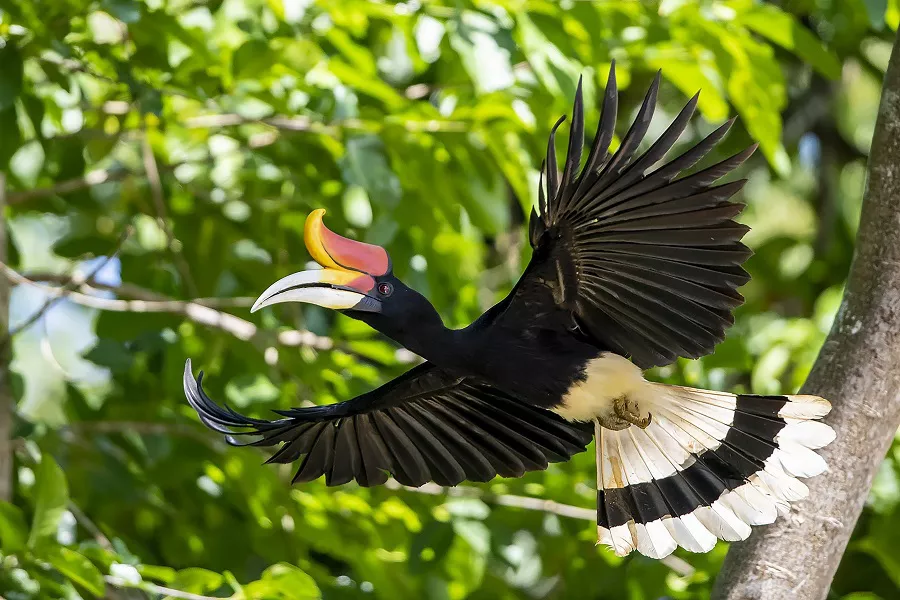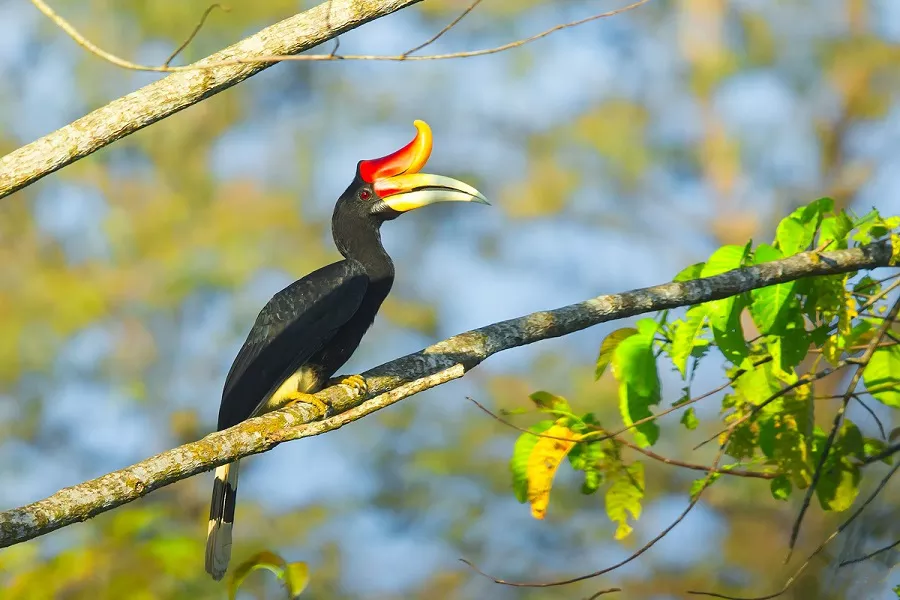Malaysia, a country renowned for its rich biodiversity and stunning landscapes, proudly showcases its national symbols that represent its cultural heritage and natural treasures. Among these symbols, the Rhinoceros Hornbill (Buceros rhinoceros) holds a special place as the national bird of Malaysia. In this article, we explore the significance, characteristics, and conservation efforts surrounding Malaysia’s majestic avian ambassador.
Malaysia’s National Bird: The Rhinoceros Hornbill
The Rhinoceros Hornbill was designated as the national bird of Malaysia in the 1990s, the Rhinoceros Hornbill holds a special place in the hearts of Malaysians. Its significance goes beyond its majestic appearance; it serves as a reminder of the country’s commitment to preserving its natural heritage. This iconic bird represents the diverse and unique fauna found within Malaysia’s tropical rainforests.
Physical Characteristics
The Rhinoceros Hornbill is a large arboreal hornbill, 80 to 90 cm (31–35 in) long, with a wingspan of up to 150 centimeters (59 inches). The weight varies by sex, with males weighing around 2,465 to 2,960 g (87.0–104.4 oz) and the females 2,040 to 2,330 g (72–82 oz). Its most distinctive feature is the impressive casque on top of its bill, resembling the horn of a rhinoceros, from which it derives its name.
In terms of coloration, the Rhinoceros Hornbill is predominantly black with white legs and vent and a white tail with a black band. The huge bill and casque are orange and red, the colour coming from preen oil rubbed on from the preen gland above the tail. One notable characteristic of this species is sexual dimorphism, where males and females can be distinguished by differences in eye color. The eyes of the male are red with black rims, and white with red rims in the female.
Habitat and Geographical Range
The Rhinoceros Hornbill is predominantly found in the lush, tropical rainforests of Southeast Asia, particularly in Malaysia’s lowland and montane regions. Its range extends across the Malay Peninsula, including the states of Peninsular Malaysia, and into the islands of Borneo and Sumatra.
Within its habitat, the Rhinoceros Hornbill prefers primary and secondary forests with dense canopy cover, as these provide ample nesting sites and a diverse array of fruits for food. However, habitat loss due to deforestation poses a significant threat to its survival.
See Also: New Zealand’s National Bird
Diet and Ecosystem Role
As a frugivorous bird, the Rhinoceros Hornbill plays a crucial role in seed dispersal within its ecosystem. Its diet consists mainly of fruits, including figs, berries, and palm fruits. By consuming a variety of fruits and excreting the seeds in different locations, the hornbill contributes to the regeneration and diversity of plant species in the forest.
In addition to fruits, the Rhinoceros Hornbill may also consume small animals, insects, and occasionally carrion, making it an opportunistic feeder within its habitat. Despite its large size and formidable bill, the hornbill has few natural predators, with threats mainly coming from humans, including habitat destruction and hunting for its casque and feathers.
Cultural Significance
The Rhinoceros Hornbill holds a special place in Malaysian culture, particularly among indigenous communities such as the Orang Asli and Dayak people. It is revered as a symbol of strength, wisdom, and prosperity, often depicted in traditional art, dances, and ceremonies.
In Malaysian folklore, the hornbill is associated with various myths and legends, portraying it as a messenger between the human world and the spirit realm. Its distinctive call is believed to carry messages from ancestors or spirits, making it a sacred bird in many indigenous beliefs.
The casque of the Rhinoceros Hornbill holds particular significance in traditional ceremonies and rituals, symbolizing power and protection. Among certain communities, the casque is used in ceremonial headdresses or as decorative ornaments, reflecting the bird’s cultural importance.
Conservation Status
Despite its cultural significance and protected status as Malaysia’s national bird, the Rhinoceros Hornbill faces numerous threats to its survival, the species was uplisted to vulnerable from near threatened on the IUCN Red List in 2018.
Habitat loss due to deforestation, primarily for agricultural expansion and logging, poses the most significant risk to the species. Additionally, illegal wildlife trade, including the poaching of hornbills for their casques and feathers, further exacerbates their decline.
In response to these threats, Malaysia has implemented various conservation initiatives aimed at protecting the Rhinoceros Hornbill and its habitat. These efforts include establishing national parks, wildlife reserves, and protected areas that encompass critical habitats, providing a safe haven for the Rhinoceros Hornbill to thrive.

Rhinoceros Hornbill
Interesting Facts about Malaysia’s National Bird :
1. Rhinoceros Hornbills exhibit a fascinating breeding behavior known as “courtship feeding.” During courtship, the male hornbill offers food to thes the pair’s partnership during the nesting season.
2. When the chicks are born, their parents seal them inside the nest and provide them food until they are robust enough to break the barrier for freedom.
3. The horns of rhinoceros hornbills are made of keratin, the same substance of which human fingernails are made.
4. The average lifespan of rhinoceros hornbill when caged or in captivity is 30-35 years.
5. The breed of rhinoceros hornbill is endemic to the rain forests and Islands of Java and Malaysia.
6. The eyes of the male are red with black rims, and white with red rims in the female.
7. The horns of rhinoceros hornbills are used for making expensive jewelry and ornaments.
8. The male and female rhinoceros hornbills are of the same size, they do not show sexual dimorphism.
In conclusion, the Rhinoceros Hornbill stands as a symbol of Malaysia’s natural heritage and cultural identity. As Malaysia’s national bird, it represents the country’s commitment to biodiversity conservation and the preservation of its unique ecosystems. By raising awareness about the importance of protecting this iconic species and its habitat, Malaysia strives to ensure the continued survival of the Rhinoceros Hornbill for future generations to admire and cherish.
FAQs
1. What is the national animal of Malaysia?
The national animal of Malaysia is the Malayan Tiger (Panthera tigris jacksoni). Known for its distinctive stripes and majestic presence, the Malayan Tiger symbolizes strength, courage, and national pride in Malaysia.
2. What is the national flower of Malaysia?
The national flower of Malaysia is the Bunga Raya, also known as the Hibiscus (Hibiscus rosa-sinensis). With its vibrant red petals and symbolic significance representing unity, peace, and courage, the Bunga Raya holds a special place in Malaysian culture and identity.
3. What is the national fruit of Malaysia?
The national fruit of Malaysia is the Durian (Durio spp.). Often referred to as the “King of Fruits,” the Durian is known for its unique taste, strong aroma, and thorny exterior. Despite its divisive nature, it is deeply cherished by many Malaysians and is a symbol of national heritage.
4. What is the national tree of Malaysia?
The national tree of Malaysia is the Merbau (Intsia spp.). Renowned for its durability, strength, and versatility, the Merbau tree is an essential component of Malaysia’s rich biodiversity and tropical rainforest ecosystems.
5. What is the national food of Malaysia?
While Malaysia boasts a diverse culinary landscape with a plethora of delicious dishes, one iconic national dish is Nasi Lemak. Consisting of fragrant rice cooked in coconut milk, served with anchovies, peanuts, boiled eggs, cucumber slices, and spicy sambal (chili paste), Nasi Lemak is beloved for its rich flavors and cultural significance, representing the multicultural heritage of Malaysia.


 Facebook
Facebook  Instagram
Instagram  Youtube
Youtube 